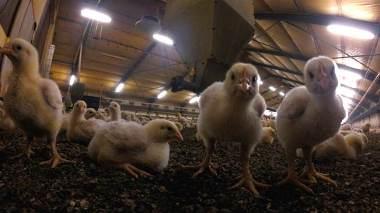Introduction
Background
On-farm animal welfare assessment has become more important in livestock production within the last years as it considers animal health, productivity and product quality of farm animals.
Broiler chicken ( Gallus gallus domesticus ), birds kept for meat production, are the fastest growing farm species (Meluzzi and Sirri, 2009) and are therefore highly prone to various welfare problems. Intensively managed birds are restraint in barren environments with minimal environmental stimulation what decreases their ability to cope with altering situations (Jones and Hocking, 1999). Consequently, sudden changes in their environment and exposure to humans are considered the most fearful events broiler chicken can experience (Jones, 1996), to which they react with freezing, escape or flight behaviour (Meluzzi and Sirri, 2009). But an extreme fear response, such as panic, can lead to increased damage and higher mortality rates during management, catching and transport of broiler chicken. Prolonged periods of fearful events are further considered a major source of stress (Rushen et al., 1999) which can lead to the development of health problems and thus, reduce welfare and limited productivity (Hemsworth and Coleman, 2010; Hemsworth, 2003; Jones, 1996; Waiblinger et al., 2006). As the stockperson’s behaviour is one of the major variables that determine the level of fear broiler chicken might develop (Hemsworth and Coleman, 2010), a measure to investigate the human- animal- relationship is included in the welfare assessment protocol for broiler chicken (Welfare Quality®, 2009).
Broiler chickens activity is known to vary over time with a main peak at approximately 21 to 26 days of age (Nielsen et al., 2003) followed by a continuous decrease due to an increase in temperature, metabolic rate, and stocking density and consequently, a decrease in the walking ability. However, not much is known about daytime dependent behaviour pattern of intensively managed broiler chicken and the influence on the outcome of the applied fear test.
Aim
This study aimed at investigating the influence of daytime and age on the performance of commercial broiler chicken in two applied fear tests. Further, the effect the observer location in the chicken house has on the outcome of the tests was studied.

Responsible for this page:
Director of undergraduate studies Biology
Last updated:
06/01/15
